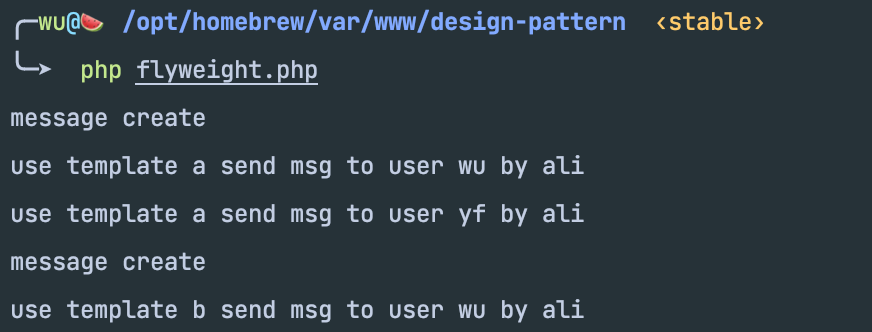享元模式会尽量使相似的对象共享内存,能让你在有限的内存中载入更多对象。
当一个应用程序需要创建大量对象,并且这些对象的大多数状都可变为外部状态时,就很适合享元模式。
一如既往的举个🌰:
1
2
3
4
5
6
7
8
9
10
11
12
13
14
15
16
17
18
19
20
21
22
23
24
25
26
27
28
29
30
31
32
33
34
35
36
37
38
39
40
41
42
43
44
45
46
47
48
49
50
51
52
53
54
55
56
57
58
59
60
61
62
63
64
65
66
67
68
69
70
71
72
73
74
75
76
77
78
79
80
81
82
83
84
85
86
87
88
89
| interface Message
{
public function send(User $user);
}
class AliMessage implements Message
{
protected Template $template;
public function __construct(Template $template)
{
$this->template = $template;
}
public function send(User $user)
{
echo 'use ', $this->template->getTemplate(), ' send msg ', 'to user ', $user->getName(), ' by ali', PHP_EOL;;
}
}
class MessageFactory
{
protected array $messages = [];
public function getMessage(Template $template)
{
$key = md5($template->getTemplate());
if (!array_key_exists($key, $this->messages)) {
echo 'message create', PHP_EOL;
$this->messages[$key] = new AliMessage($template);
}
return $this->messages[$key];
}
}
class Template
{
protected string $template;
public function setTemplate(string $template)
{
$this->template = $template;
}
public function getTemplate(): string
{
return $this->template;
}
}
class User
{
protected string $name;
public function setName(string $name)
{
$this->name = $name;
}
public function getName(): string
{
return $this->name;
}
}
$templateA = new Template();
$templateA->setTemplate('template a');
$templateB = new Template();
$templateB->setTemplate('template b');
$userA = new User();
$userA->setName('wu');
$userB = new User();
$userB->setName('yf');
$factory = new MessageFactory();
$flyweightA = $factory->getMessage($templateA);
$flyweightA->send($userA);
$flyweightA->send($userB);
$flyweightB = $factory->getMessage($templateB);
$flyweightB->send($userA);
|
这次来点不一样的,贴张截图帮助理解:

可以看到,在享元工厂中,一共创建了两次 message,当我们重复用一个模板发送消息时,模板作为内部状态已经被缓存了,调用的时候直接取出即可,避免了重复创建造成的资源浪费。
例子虽然不太贴切,但是看完应该也能总结出,享元模式需要依赖于一个享元工厂以及一个享元角色,也就是咱们代码中的 AliMessage 类。


